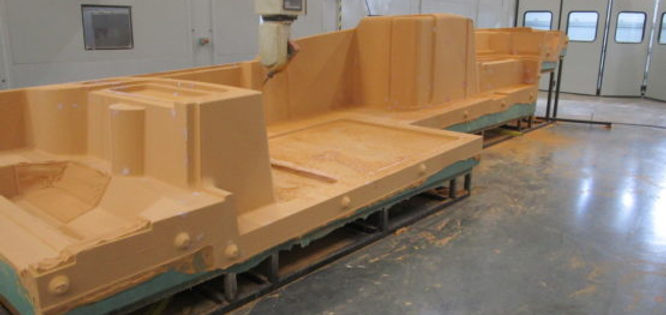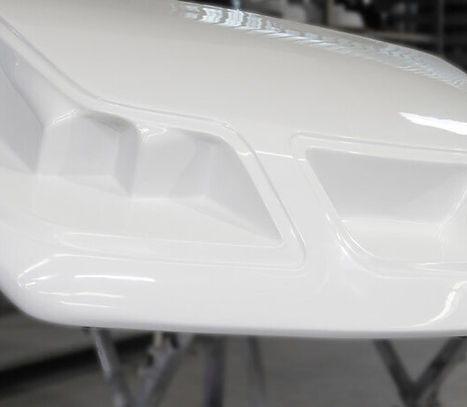PART FABRICATION
Investing in quality tooling is a surefire way to ensure great parts.





Open Molded Product - Infused Product - Carbon Fiber Fabrication - Metal Integration - Full Size On Site Assembly
Painting - First Article Testing Components - Fit Validation










_edited.jpg)












.jpg)
What is a composite material? A composite material is produced by combining two or more different materials (typically a fiber-reinforced phase + a matrix/resin phase) to create a material that provides better mechanical/functional properties than any single component. The most common construction is: fiber (glass, carbon, aramid/Kevlar) + matrix (epoxy, polyester, vinylester or thermoplastic resins). Fibers act as the load-carrying element (high tensile/strength), while the resin transfers loads to the fibers, preserves shape and provides environmental protection. Key advantages High strength-to-weight ratio — lightweight yet strong. Corrosion resistance — advantageous in marine and chemically aggressive environments. Design flexibility / anisotropy — strength can be tailored by orienting the fibers in desired directions. Vibration damping and thermal insulation properties. Aesthetic surfaces & integration — enables single-piece manufacture of complex geometries. Main material types Glass fiber (GFRP): cost-effective, good impact resistance, widely used in marine applications. Carbon fiber (CFRP): high strength and stiffness per weight; preferred in aerospace and high-performance applications. Aramid (Kevlar): good impact/delamination resistance; used in armor and some marine applications. Matrix resins: epoxy (high performance, aerospace), polyester/vinylester (marine, general use), thermoplastics (PEEK, PPS — high-temperature performance and improved recyclability). Manufacturing / processing methods (brief) Hand-layup / spray-up: common for small/medium parts, frequently used in boatbuilding. Vacuum infusion / Resin Transfer Molding (RTM): better repeatability and lower void content. Prepreg + autoclave (vacuum oven): hybrid/long-life parts; aerospace standard. Compression molding, thermoplastic forming: suitable for high-volume production, increasingly used in automotive. Pultrusion, filament winding: efficient for producing rods, cylinders and pipes. Sectoral applications and why they are preferred Marine Typical uses: hulls, superstructures (decks, cabins), masts, rudders, composite propeller housings, buoys/lighthouses, and offshore wind-foundation components. Why: resistance to saltwater corrosion, high strength-to-weight (fuel savings), the ability to produce large single-piece molds, and good impact resistance. GFRP is common in marine workboats and leisure craft; CFRP is chosen for racing and high-performance vessels. Aerospace Typical uses: fuselage and wing panels, tails, flaps, interior structural elements, composite cabin panels and landing-gear fairings. Why: extreme requirements for weight savings, fatigue resistance and high mechanical performance. Aerospace typically uses carbon-prepreg cured in autoclaves. Strict certification and traceability requirements also apply. Automotive Typical uses: body panels, hoods, roofs, bumpers, specialized fuel tanks, door panels, chassis/subframe elements (especially for high-performance/electric vehicles), and sports/racing components (chassis, diffusers). Why: weight reduction improves fuel efficiency and range; composites allow complex shapes and energy-management in crashes when properly designed. GFRP is widespread; CFRP use is growing in luxury and performance segments. For mass production, thermoplastic composites, RTM or compression molding are preferred. Design and production considerations Anisotropic behavior: mechanical properties depend on fiber orientation — correct layup (layer orientation) is essential. Joining: composite-to-composite or composite-to-metal joints require engineered bonding or mechanical fastening (adhesives, inserts, specially designed fasteners). Thermal / fire behavior: critical for aerospace and rail applications — choose resins and systems that meet fire, smoke and toxicity standards. Manufacturing tolerances and surface quality: mold quality and process control directly affect performance. Inspection / quality control: NDT methods such as ultrasonic, X-ray, thermography and visual inspection are standard—especially to detect delamination. Repair & maintenance: repairs differ from metals and require lamination/patch techniques and material compatibility planning. Disadvantages / limitations Cost: carbon + prepreg + autoclave processes are expensive. Recycling / end-of-life: thermoset matrices are difficult to recycle; thermoplastics are easier to recycle but have different cost/performance trade-offs. Temperature resistance: some resins lose performance at high temperatures. Manufacturing complexity: mold quality, process parameters and workforce skill level directly affect final performance. Practical example scenarios For a boat hull, GFRP with infusion is often preferred (cost and water resistance improved). For an aircraft wing panel, carbon-prepreg + autoclave is used to achieve high stiffness and reliable fatigue life. For an EV roof or chassis element, thermoplastic composite + compression molding is suitable for series production and offers recyclability advantages. Conclusion — when to choose composites? Choose composites when weight minimization and corrosion resistance are priorities. If the project requires high certification, high cost tolerance and peak performance (aerospace, racing automotive), CFRP is the typical choice. If cost and series production dominate, GFRP or thermoplastic composite methods are usually the most practical solutions.
THE ULTIMATE PARTNERSHIP
At HYDROLUIS, we deliver more than just outstanding designs, precision patterns, and molds — we create the ultimate partnership by ensuring that our customers receive high-quality parts, on time, ready for integration into their assembly systems.
As industries worldwide adopt advanced practices such as just-in-time inventory systems from the automotive sector, HYDROLUIS provides the key to successful product launches. From production run hatches for pleasure craft to large-scale complex assemblies such as amusement rides and simulation systems, our team ensures precision and reliability at every stage.
What truly sets HYDROLUIS apart is our strategic location in Europe, which allows us to serve all European countries with unmatched speed, access, and efficiency. Combined with our unique labor cost advantages across multiple countries, we provide pricing and service levels that are simply incomparable within the European market.
Our custom fabrication capabilities begin with close collaboration with customers, ensuring expectations are met in a repeatable, consistent, and efficient manner. Whether utilizing newly created tooling from our in-house team or customer-supplied tools, our parts division can produce anything from one-off components to full-scale annual production runs.
